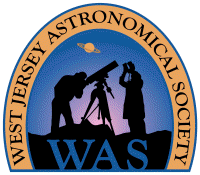| Weather Links |
Mercury 2025,
last sighting June 22 |
Lunar X
|
Omega Centauri |
Barnard's Star
|
Bald Eagles |
T CrB |
Keid |
(4) Vesta 2025
2014 to 2035 |
Moon and Mars
June 29, 2025

|
On June
29, 2025, the
Crescent Moon
passed close to the
Planet Mars
towards the end of evening twilight. This snapshot of them was
captured from Bishop's Gate in Mt Laurel, NJ, at 10:15 pm EDT.
It was taken with a Canon EOS RP dslm camera and a Canon 400 mm,
f/5.6L telephoto lens on a fixed tripod. It was exposed 1/30
second at f/5.6, ISO 1600. The only processing was to setting
the white balance from the original daylight to 4200°K in
Canon's Digital Professional 4. It was also cropped to a
4:3 ratio, about half the original linear dimensions, to a field
2.5° wide x 1.9° high. At the time, the sky had hazy thin clouds
in that direction, hence the fogginess around the bright
crescent (the Moon was 4.6 days old, 24% illuminated and 15° altitude).
The apparent separation between them was 0.65° center-to-center,
or 0.40° from the lunar limb to Mars. Although the Moon appears
much larger than Mars as seen from earth, Mars is almost twice the twice
the physical diameter, 4,213 miles vs. 2,160 miles for the Moon,
but since Mars is much farther away, 1.9 au vs. 241,346 miles
for the Moon (1/345 au), that puts Mars 732x as far away. As a
result, the Moon is 30.77 arc minutes, or 1,846 arc seconds, in
apparent diameter vs. 4.9 arc seconds for Mars (magnitude +1.5,
92% illuminated). Sky Tools showed the closest approach (the
appulse) was 0.62°
at 9:50 pm for this location (parallax is not negligible for the
relatively nearby Moon). The Moon was moving eastward, towards
the upper left in this view, at the rate of its own nominal 0.5°
diameter every hour. |
Nova V462 Lupi
June 23, 2025
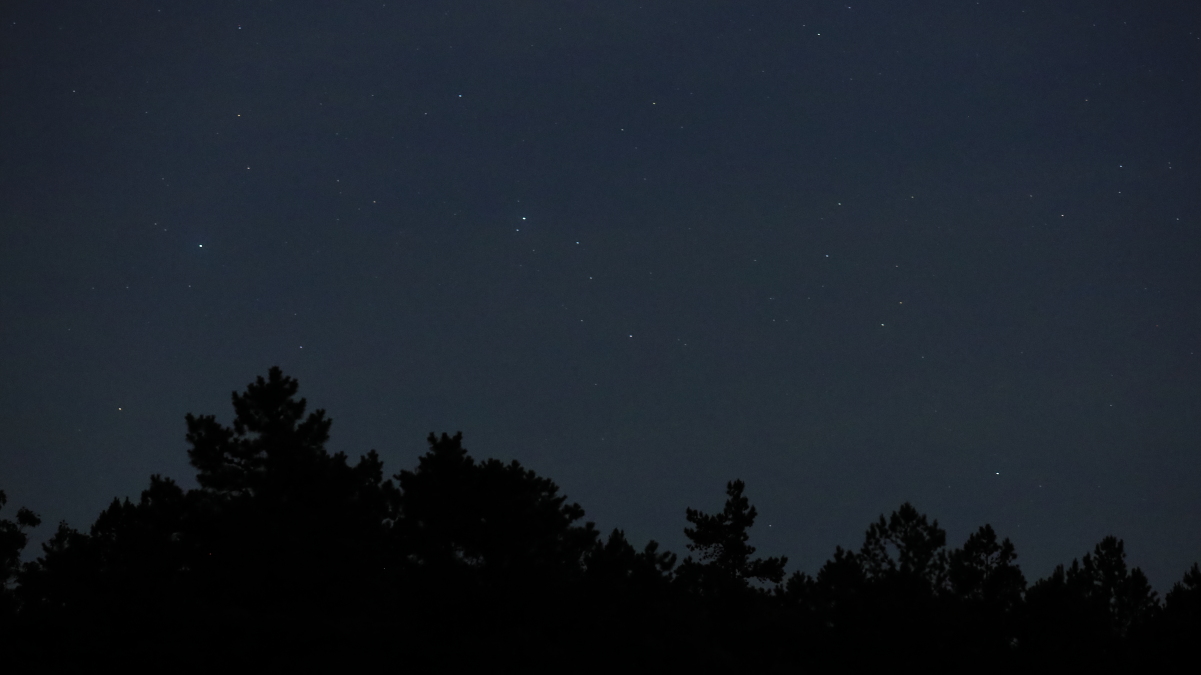
|
Recently discovered
Nova V462 Lup
was captured on June
23, 2025, from Carranza Field in Wharton State
Forest, NJ. This image was taken at 10:49 pm EDT with a Canon
EOS RP DSLM camera and a Canon 200 mm, f/2.8L telephoto lens on
a fixed tripod. It was exposed 4 seconds at f/3.5, ISO 6400,
then mildly adjusted in Canon's Digital Photo Professional 4,
set to 3600 K white balance and cropped to a 16:9 ratio for a
field 9.6° wide x 5.4° high. More details about this nova are
discussed in the sections below, but here are recent
visual estimates at the AAVSO. Mouseover for labels.
The blue numbers on mouseover are the magnitude values (absent
the central decimal point) as provided by SkyTools 4. From this
image, I think magnitude 6 would be a reasonable estimate.
Transparency was poor,
such that I could not see the nova in 12x50 binoculars. This was
possibly due to Canadian forest fire smoke, and in
addition, it was very muggy after a daytime high around
100°F. |
Nova V462 Lupi
June 18, 2025
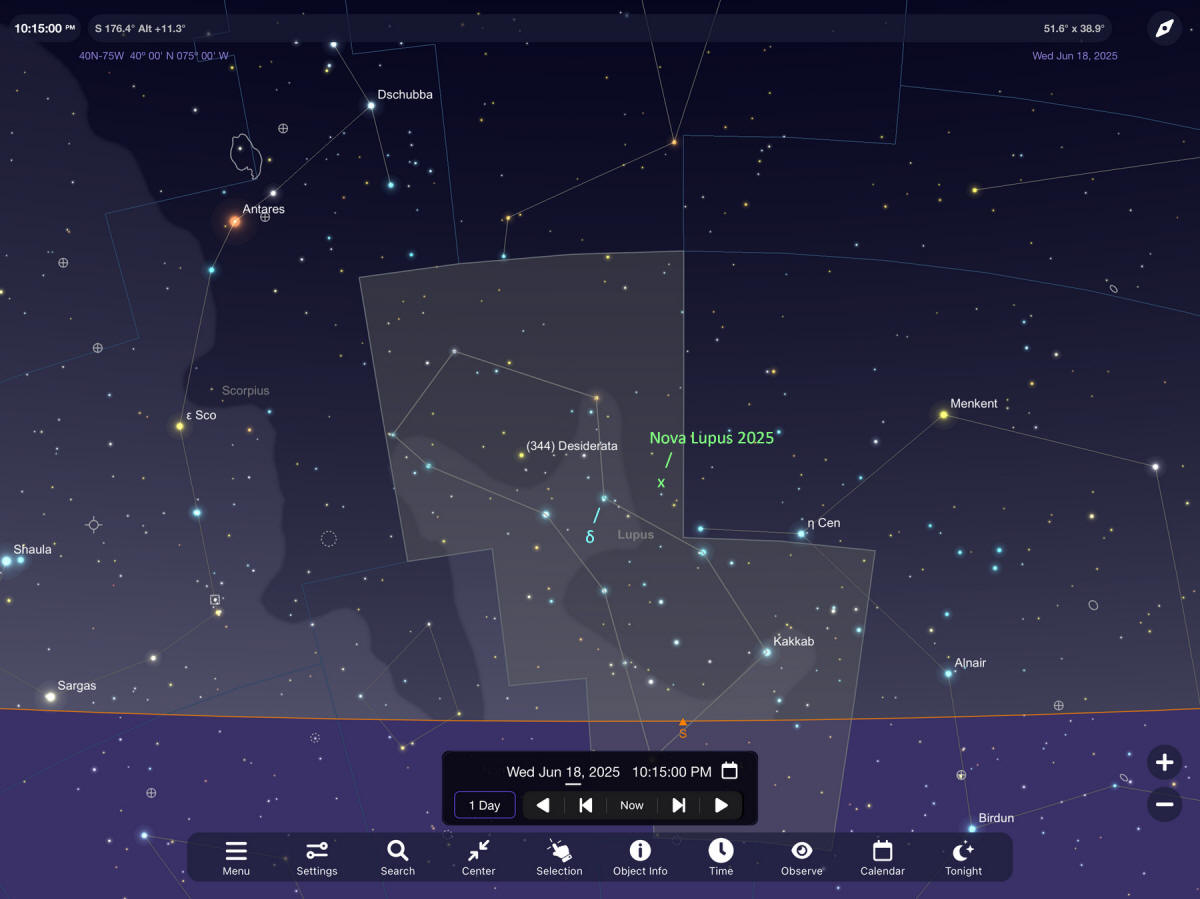
|
There was a recently discovered nova in
the constellation
Lupus as
discussed in this
Bob King online article at Sky & Telescope. This Nova is of
note due its brightness, reaching the nominal magnitude 5.x
range as of this writing (June 19, 2025) per recent
visual estimates at the AAVSO (this is an updated and now
functional link). The chart above is a
SkySafari screen clip showing the nova's position near transit,
about 10° altitude for an observer at 40°N latitude.
The chart below is a SkyTools screen clip,
a close-up of the area around the nova.
Here's
a printable PDF version.
For reference, V462 Lup is
about 2.5° west of Delta Lup. The objects outlined in a
salmon-pink color are handy skymarks for finding it
visually. On the evening of
June 18, 2025, I was able to spot it
at 10:47 pm EDT with 8x42 binoculars from Bishops Gate in
suburban Mt Laurel, NJ, under a largely clear sky. With 15x56
binoculars, my rough magnitude estimate was 6, perhaps a little
brighter.
On June 22 at the
Barnegat Rd observing site, after spotting it with the 12x50s,
the nova was observed with a 12.5-inch Newtonian. |
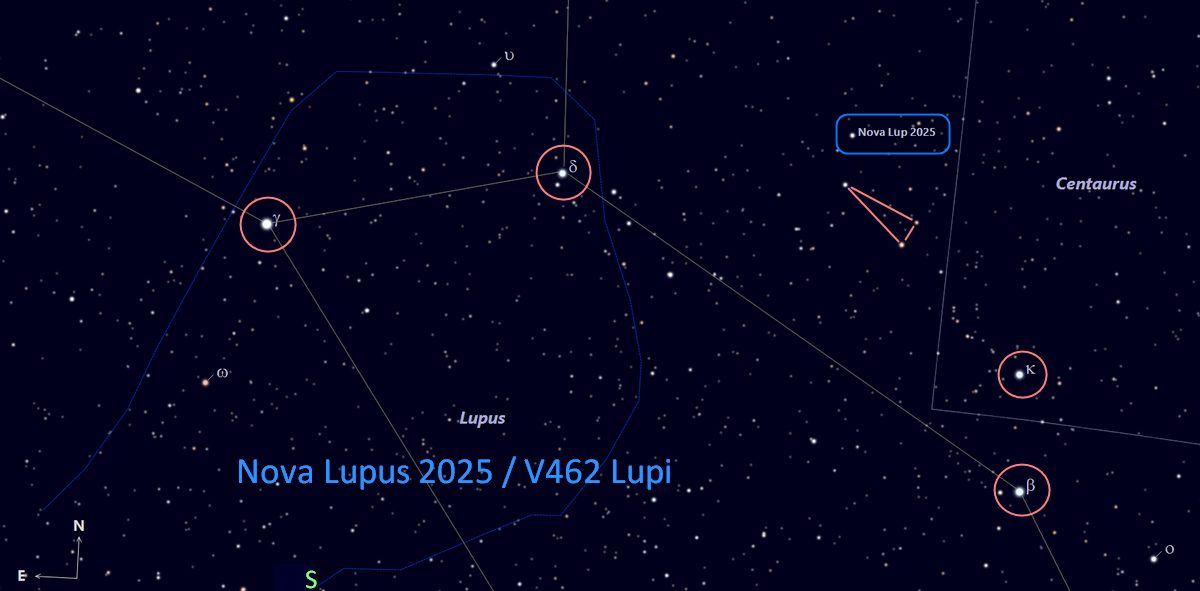
The Moon, a Southerly Transit
June 12, 2025
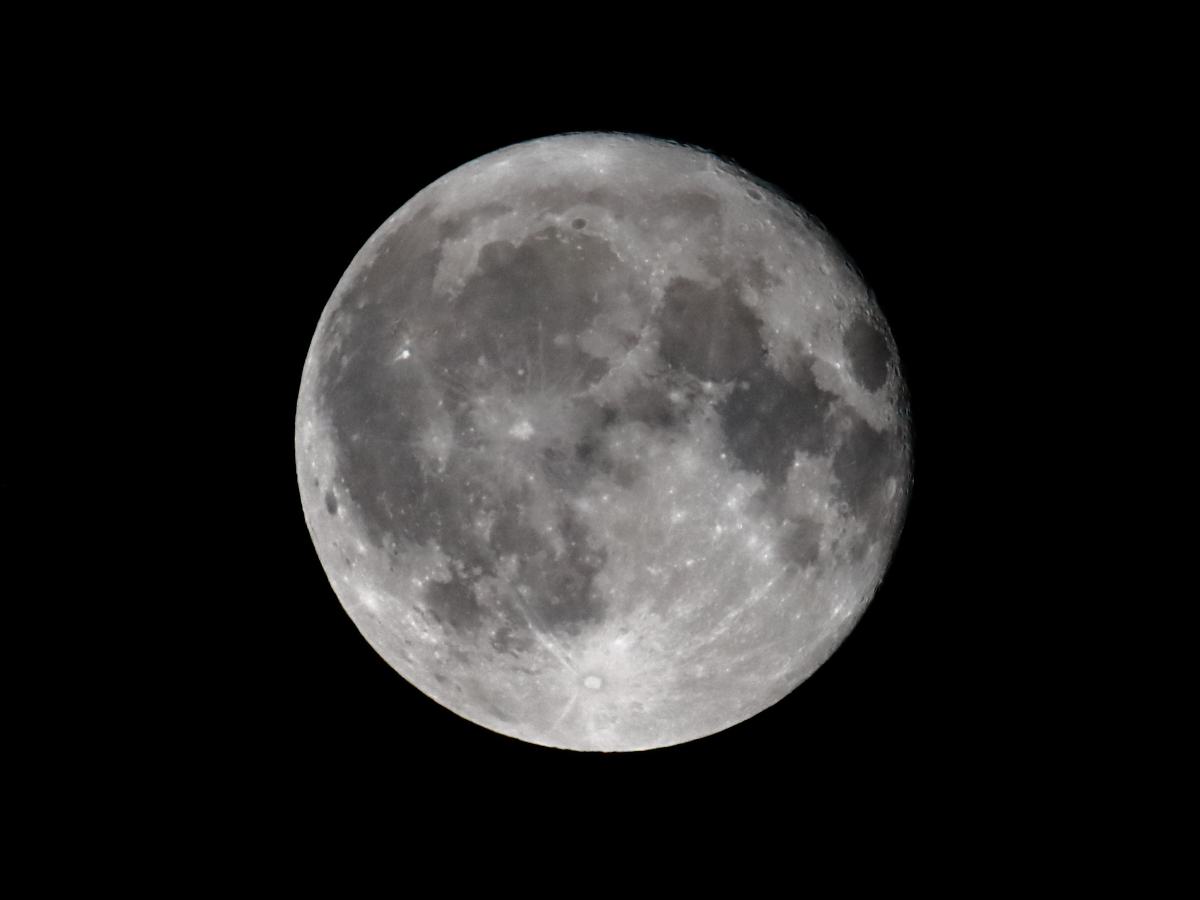
|
Here's the waning
Gibbous Moon on June
12, 2025, 21 hr 46 min past full, as seen from
Maple Shade, NJ. Initially, the purpose was a test of my Tamron
150 to 600 mm f/5 to 6.3 telephoto zoom lens with a Kenko 1.4x extender.
Setting the lens to 600 mm, the extender yielded an effective
focal length of 840 mm at f/8.8. This snapshot of the Moon, a
single raw frame taken at 1:30 am EDT with a Canon EOS RP DSLM
camera and the Tamron lens on a fixed tripod, was
manually exposed 1/2000 sec at f/11, ISO 3200, daylight white
balance then converted in post processing with Canon's Digital Professional Pro 4
to auto white priority. Brightness and contrast were also mildly
adjusted using DPP4, then it was cropped to
38% of the width x 43%
of the height of the original dimensions to a 4:3 ratio,
providing a
field 0.94° wide x 0.71° high. Finally, it was converted to this
JPEG, reducing the original 24.3 MB raw frame to 265 KB. In any
case, the result of all this is a satisfactory image, but
probably inferior to what I would expect with my 130 mm, f/7 apo
refractor (910 mm focal length), which would require considerably
more effort to set up. Despite some Canadian forest
fire smoke earlier in the day, the sky was fairly clear, and
despite its relatively low altitude, the Moon was a nearly-white
cream color, unlike the distinct orange color of the
rising Moon in the southeast, about 4 hours earlier. In this
direct view, north is up and celestial east is to the left.
Mouseover for labels.
At the time of the picture, 1:30 am, the
Moon was at 20.9° altitude and 176.4° azimuth (so it was just shy
of the Meridian at 180°, which it would transit at 1:46 am). The
low altitude near transit of this near-full Moon is a result of
the
lunar standstill (or lunistice), when the Moon's orbit is near its maximum
southerly tilt with respect to the ecliptic over its 18.6 year
lunar cycle. This is the flip side of the Full Moon being at its
maximum altitude back in January 2025.
Here's a SkyTools chart of the Moon at 1:30 am on June 12.
The Moon is at a southerly dip in its undulating track in the
sky, which is due to the changing earth-based observer's
location as the earth rotates. Correspondingly, the Moon's right
ascension here is close to that of the winter solstice on the
ecliptic, which is the ecliptic's most southerly point.
The APOD of June 20, 2025, features the recent lunar
standstill. |
Sighting a Very Old Crescent Moon
a new personal record
May 26, 2025
|
With New Moon occurring at 11:02 pm EDT on Monday, May
26, 2025 (per USNO MICA 2.2.2
software), I had been looking
forward to spotting a nice young Moon on Tuesday evening after
sunset. At 9 pm EDT, the Moon would be about 22 hr old and 1.3%
illuminated, a splendid sight. However, late Sunday evening, May
25, I realized that I might have a chance to see a very old
crescent Moon on Monday morning, May 26, before sunrise. It
would be about 18 hr before new and 0.9% illuminated at 5 am. Up
to this point, my personal record for an old Moon
sighting is 19
hr 09 min before new on December
28, 2016, and my young Moon
sighting record
is 20 hr 01 min old on
February 3, 2011.
So, with a clear sky Monday morning, I headed to Marter Ave in
Mt Laurel, NJ, which has a nominal 1° horizon to the east. I
arrived at 4 am and immediately spotted Mirach (Beta And), which
was at the same nominal 62° azimuth as the Moon would be at 5
am, shortly after moonrise at 4:44 am. I dropped a vertical line
from Mirach to the horizontal roofline of a distant warehouse
building, providing a reference point near a couple of slightly
protruding treetops. While the sky in general was cloud free,
there were thin murky streaks low along the eastern horizon (but
for this area, suburban near sea level, it was almost as good as
it gets).
It was still relatively dark, since astronomical twilight began
at 3:40 am and sunrise would be at 5:36 am, so I set up my
35x115 spotting scope on a passive alt-azimuth mount and looked
at Saturn while I waited. Since I
don't have a finder on this scope, an
initial "gun barrel" pointing near Saturn picked up a couple
of "stars" on a diagonal line, which I suspected were the star
HD 6 and the planet Neptune, a couple of
degrees to the left of Saturn (see the second picture down below). So,
I pointed a little to the right, and there was Saturn, sans any
visible rings.
I started looking for the Moon casually with the 35x115 scope about 4:50
am, but as 5 am approached, I looked more seriously.
At 4:59 am, I spotted the remarkably thin crescent
very near the
expected position. At the time, it was 1° 59′ altitude, so with
a lunar diameter of 33.3′ at the time, the bottom of the
crescent was about 1.7° altitude. The thin crescent extended
about 75% of the lunar circumference, centered at the 7:30
o'clock position. It looked a little lumpy from atmospheric
turbulence.
After spotting it with the 35x115 scope, I had a brief look with
15x56 binoculars, but subsequently, I just followed the crescent
with the scope until 5:21 am when it was 0.8% illuminated, 5.5°
altitude. I lost it when I moved the scope a little too much and
couldn't relocate the fading crescent in the brightening
twilight. But near the middle of those 22 minutes of visibility,
as the seeing improved with increasing altitude and before
twilight washed it out. To say the the slim crescent was a
sublime sight would be an understatement. I never saw the slim
crescent with unaided eyes. When last
seen at 5:21 am, the Moon was 17 hr 41 min before new,
shattering my previous personal record.
Despite heavy overcast, I spent almost an hour on
Tuesday, May 27 (8:30 to 9:20 pm)
hoping to catch a break in the clouds for the 22-hr-old young
Moon after sunset, which would have yielded an impressive less-than-40-hr
span between the flanking old and new Moon sightings. Alas, the clouds
prevailed and the young Moon was unseen. In any case, I was
quite satisfied to see this old Moon on Monday morning, especially since I headed
out thinking the chance of doing so was pretty low. |
The Crescent Moon and Venus
May 24, 2025
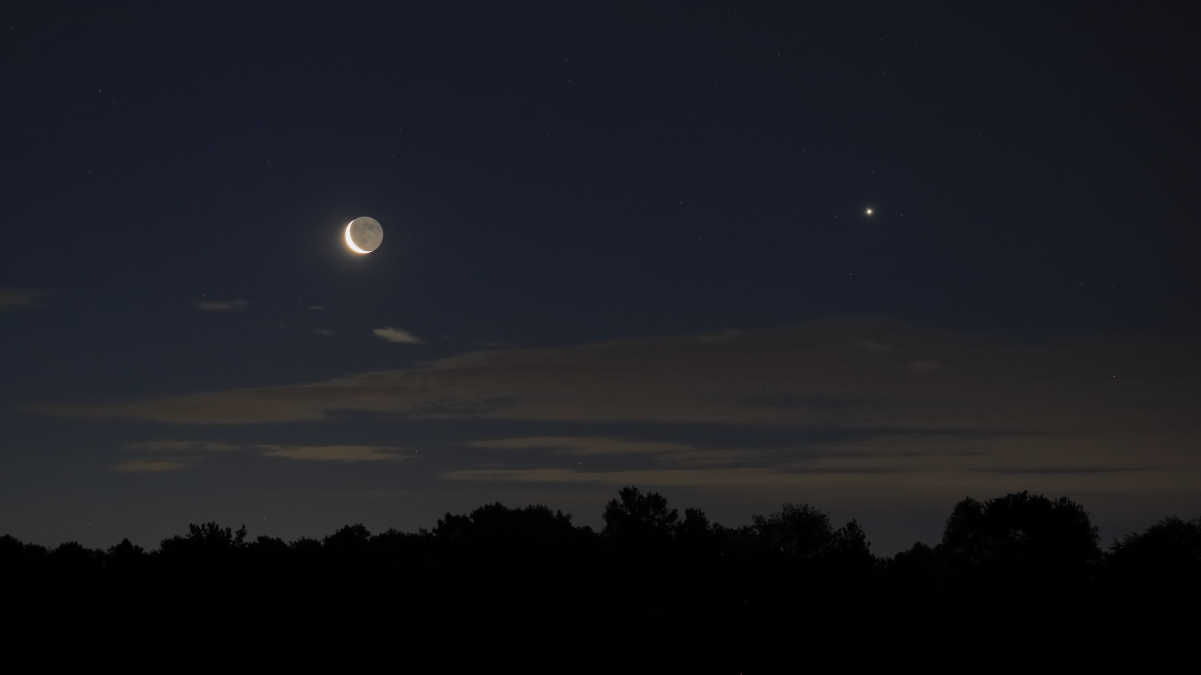
|
The planet
Venus was joined
by the waning Crescent Moon on May
24, 2025, as seen from Swede Run in Moorestown, NJ.
Astronomical twilight began at 3:42 am EDT and sunrise would be
at 5:37 am.
This snapshot of them is from a single raw frame taken at 4:16
am with a Canon EOS RP DSLM camera
and a Canon 100 mm f/2.8L macro lens on a fixed tripod. It was
exposed 1 sec at f/3.5, ISO 1600, daylight white balance and
then mildly adjusted. It was cropped to 89% of the width x 75%
of the height of the original dimensions to a 16:9 ratio,
providing a
field 18.2° wide x 10.3° high. At the time of the picture, the
Moon was at 6.5° altitude, Venus was at 6.9° altitude and they
were 7.6° apart. The Moon was 11% illuminated by sunlight (the
overexposed bright
crescent) but the remainder of the disc glows lightly from
earthshine. It can't be seen at this magnification, but Venus
was was a thick crescent, 45% illuminated. The pair made a splendid
visual sight. Mouseover for
labels. |
Neptune and Saturn
May 24, 2025
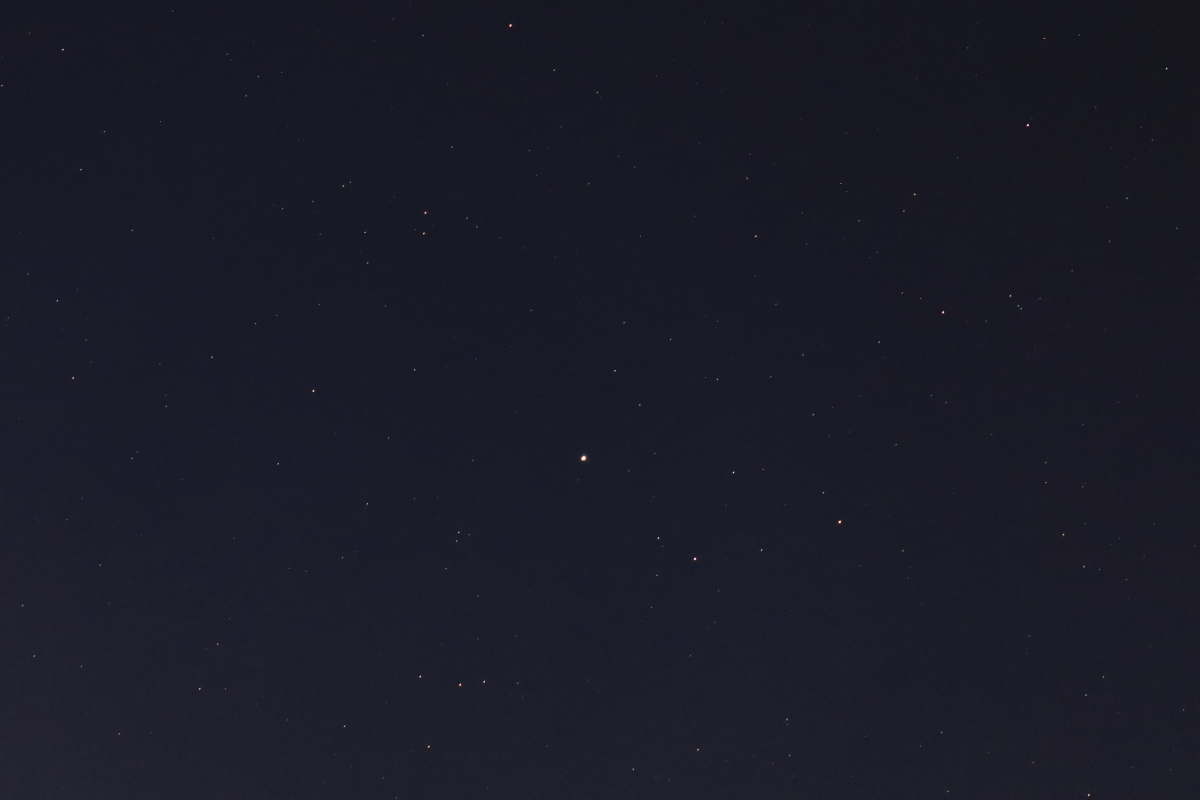
|
The distant planet
Neptune was paired
with the ringed planet
Saturn on May
24, 2025, as seen from Swede Run in Moorestown,
NJ. Astronomical twilight began at 3:42 am EDT and sunrise would
be at 5:37 am. This snapshot of them is from a single raw frame
taken at 4:08 am with a Canon EOS RP DSLM camera
and a Canon 200 mm f/2.8L telephoto lens on a fixed tripod. It was
exposed 2 sec at f/2.8, ISO 3200, daylight white balance and
then mildly adjusted. It was cropped to 72% of the original dimensions
keeping the 3:2 aspect ratio and providing a
field 7.4° wide x 5.0° high. At the time of the picture, the
two planets were 2° apart and 12.7° altitude. Dim Neptune was at
magnitude 7.9 compared to Saturn at magnitude 1.1. That 6.8
magnitude difference means
Saturn was 525x brighter than Neptune (Saturn was
visible with unaided eyes, Neptune requires optical aid to see).
Saturn's famous rings are not seen here. At this magnification,
they might only cause an elongation in the shape, but currently
from earth, we are looking at the ring plane nearly edge-on, so
even with a scope, they are nearly impossible to see now. The
tilt is increasing, and in about 7.5 years, they will reach
maximum tilt, providing the classic "ringed planet" appearance.
To the right of Saturn, there's a group of stars forming a
"hockey stick" asterism
that I used as a guide to finding Neptune the past few
years. This season,
Neptune will remain relatively close to
Saturn for an easy reference point. Mouseover for labels. |
The Crescent Moon and Jupiter
April 30, 2025
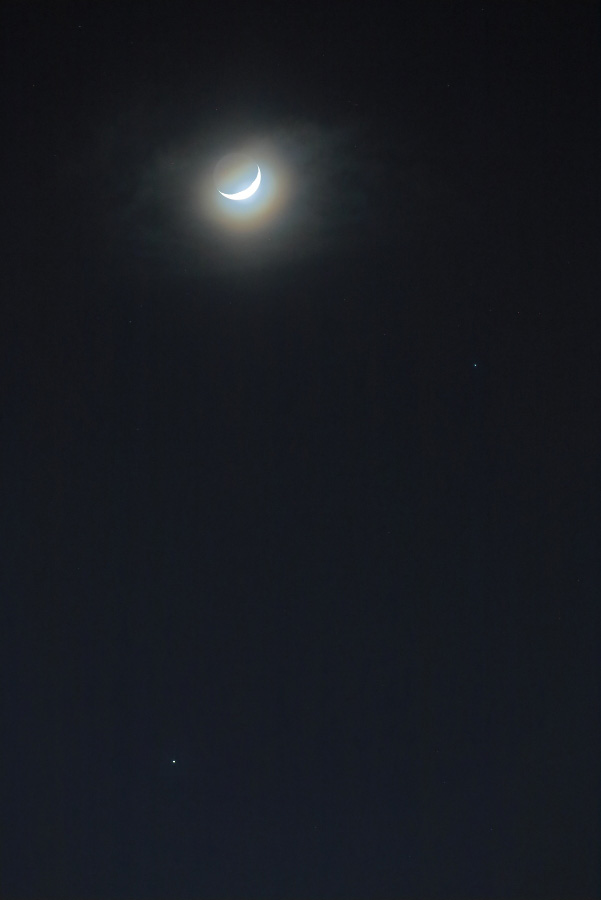
|
Transparency was less than ideal on the
evening of April 30, 2025,
when Jupiter
was about 7° below the 3.3 day old, 15% illuminated
Crescent Moon
(New Moon was on April 27 at 3:31 pm EDT). The star
Elnath, the
northern horn tip of the constellation
Taurus,
is also visible here. Mouseover for labels.
This image was captured at 10:38 pm EDT from Bishop's gate in Mt
Laurel, NJ, with a Canon EOS RP DSLM camera and a Canon 200 mm,
f/2.8L telephoto lens on a fixed tripod. It was manually exposed
1/8 second at f/4.0, ISO 1600 and lightly adjusted with Canon's
Digital Photo Professional 4. It's uncropped for a field 6.9°
wide x 10.3° high. At the time, the Moon was behind a thin
passing cloud resulting in a colorful corona from the greatly
overexposed, crescent, but that exposure showed the rest of the lunar face
illuminated with earthshine. |
Asteroid (4) Vesta's
Movement
April 26-27, 2025
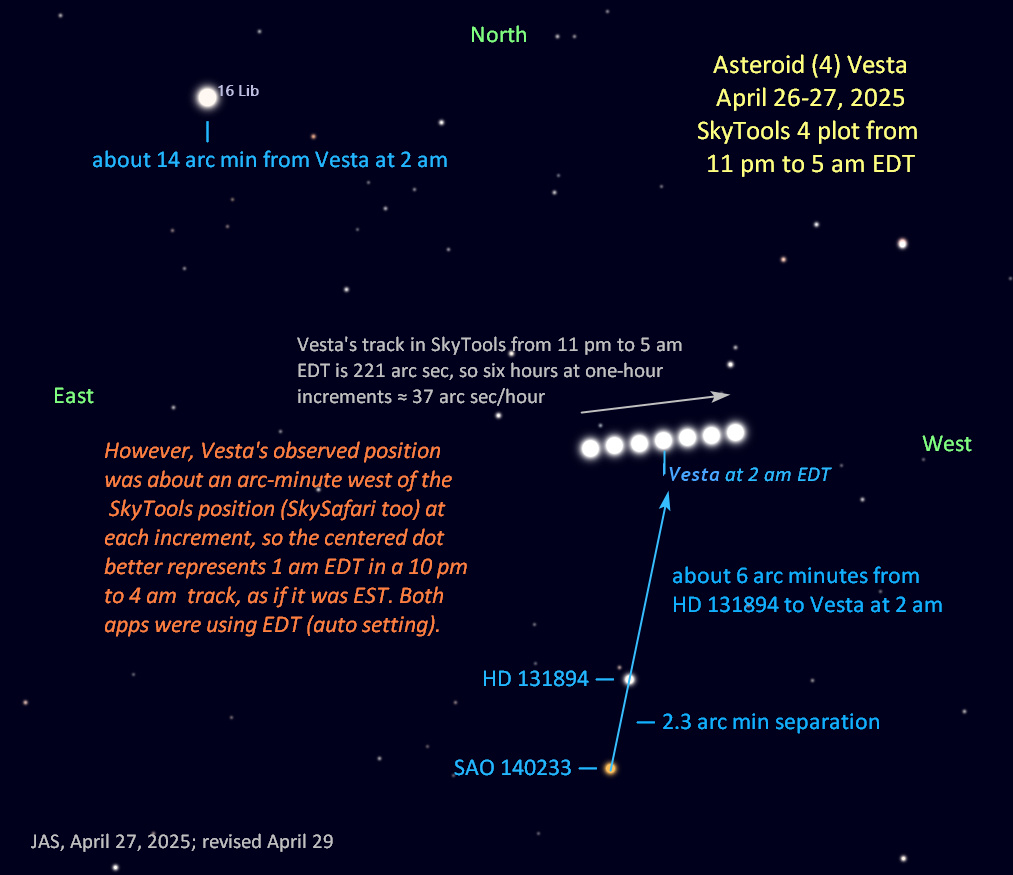
|
Weather permitting,
the night of April 26-27, 2025,
will provide a great opportunity to observe the movement of
asteroid (4) Vesta against the "fixed" firmament due to its
proximity to the pair of nominal eighth magnitude stars, HD
131894 and SAO 140233, as shown on this annotated chart from
SkyTools. A straight line from that pair will intersect Vesta
about 2:30 am on April 27. Before and after that, there will be
a definite "kink" in that line. The 37 arc sec/hour motion is
similar to Jupiter's current equatorial diameter, about 34 arc
seconds.
Update,
April 26-27: I was out
several times overnight to observe Vesta's movement with my 88
mm spotting scope at 25 to 60x. The initial sighting was 11:50
pm EDT at Atsion, then 1:10 am at Bishops Gate and finally, 3:15
am at Swede Run. Indeed, the movement vs. a line extending up
from the pair of stars was readily apparent and closely matched
the predicted positions. Revised
April 29: On further review, it
seems the dot times are an hour ahead, as if the app should be
showing the times as EST, not EDT (same with SkySafari). I don't
know why.
April 28 at
Thompson's Beach, I sighted Vesta at 12:16 am with 15x56
binoculars. The position was distinctly westward (to the right)
of the last position on April 27. Under the darker sky over the
Delaware Bay, I was able to unambiguously spot Vesta with
unaided eyes using averted vision, albeit, with difficulty. |
Comet C/2025 F2 (SWAN)
April - May 2025
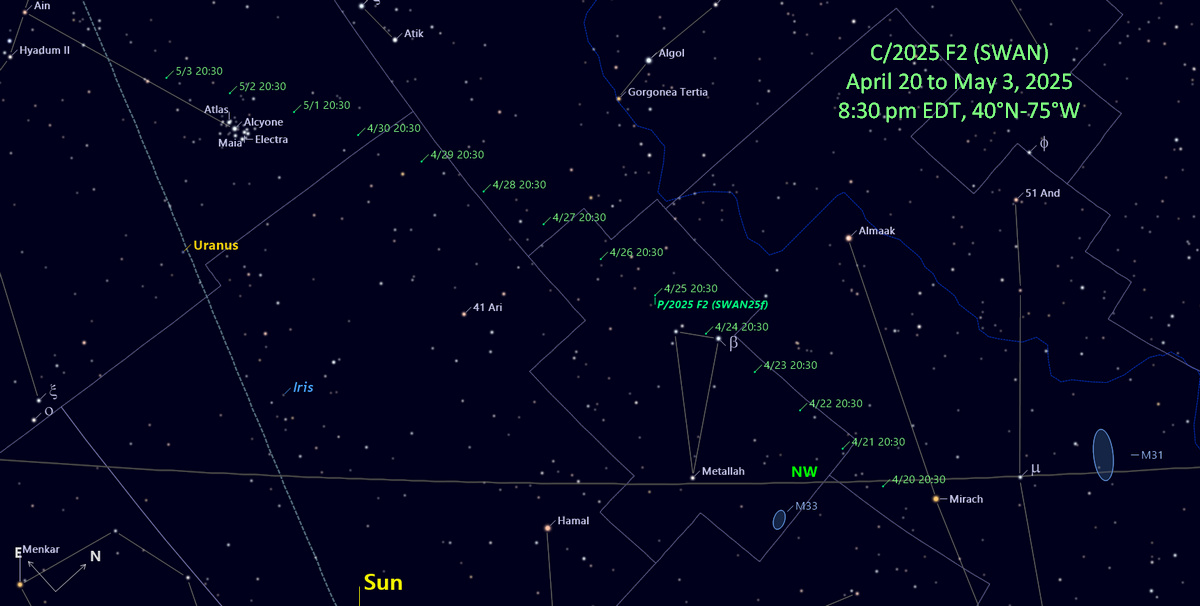
|
Recently discovered comet, initially
called SWAN25F
informally, but now officially
designated
C/2025 F2 (SWAN), made a surprising
appearance in the morning sky of the Northern Hemisphere after
it's
discovery from images from the SWAN instrument on the SOHO
spacecraft. It's
currently (as of April 11) leaving the Great Square of Pegasus and
heading into Andromeda. Current
brightness reports at COBS are largely in the magnitude 8 to
9 range, which is within reach of a modest scope. I was able to
see the dim coma, and perhaps a short vague tail, with
a 35x115 spotting scope, but nothing with 15x56 binoculars, from
Carranza Field in Wharton State Forest, NJ, on the morning of April 9, 2025 (at
the end of a rare clear night).
My non-expert magnitude estimate, based on comparison to the
defocused star SAO 91459, was 8.6.
Update, April 17, 2025:
The coma was not detected on April 17, around
5:00 to 5:15 am EDT, with a 35x115 scope at Carranza. A nearby magnitude 9.6
star was seen, even though there was an 84% illuminated Moon
behind me at 20° altitude in a clear sky during the early part of
astronomical twilight (which began at 4:40 am EDT). Discussion
on the Comet Mailing List speculates the comet is
disintegrating.
Update, April 25, 2025:
A new chart for the early evening sky has been generated for the
end of April into early May 2025.
Here's a
SkyTools ephemeris for
April
25 to May
10, 2025, at 9 pm EDT. However, it may be academic as the
evidence of F2's disintegration is mounting. As of
April 29, it's just a relic cloud
of dust. |
Venus and the Crescent Moon
March 27, 2025
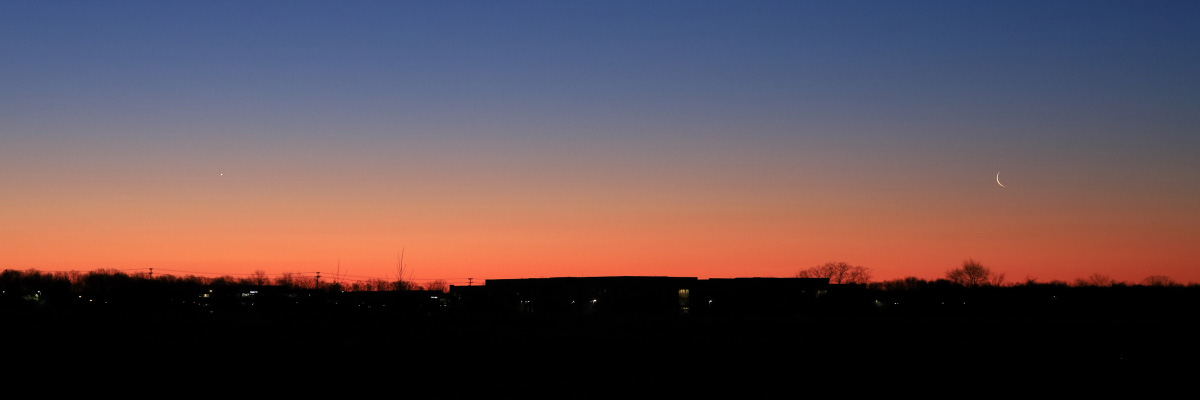
|
The planet
Venus was joined
by the Crescent Moon, on March
27, 2025, as seen from Marter Ave in Mt Laurel, NJ.
Venus entered the morning sky after inferior conjunction with
the Sun on March 22, 2025 at 9:07 pm EDT. It was
spotted from this location just before sunrise on March 23
and will continue its westward movement, reaching greatest
elongation from the Sun on May 31, 2025. In contrast, the Moon
is moving eastward towards the Sun, reaching New Moon on March
29, when there will be a
partial eclipse of the Sun, visible from our area briefly
after sunrise. Venus was visible with unaided eyes this morning,
but it's not yet the brilliant beacon it will soon become.
This snapshot of them is from a single
raw frame taken at 6:22 am EDT with a Canon EOS RP DSLM camera
and a Sigma 50 mm f/1.4 Art lens on a fixed tripod. It was
exposed 1/60 sec at f/4.0, ISO 1600, daylight white balance and
then mildly adjusted. It was cropped to 87% of the width x 43%
of the height of the original dimensions, a 3:1 ratio, for a
field 34.5° wide x 11.9° high. At the time of the picture, Venus
was at 4.2° altitude, 10.6° solar elongation and 1.7%
illuminated. The Moon was at 4.0° altitude, 27.8° solar
elongation and 5.8% illuminated. The two objects were 23.1°
apart, with Venus 8.0° above (north of) the ecliptic and the Moon 2.6°
below (south of) the ecliptic. This, and the
shallow 27° tilt of the
ecliptic resulted in the wide spacing despite being very nearly
the same altitude above the horizon. Mouseover for labels.
Update, March 29, 2025:
Here's an account of my Venus & eclipse observations on
March 29. I didn't take any pictures, but here's one of my
snapshots of the partial solar eclipse just after sunrise on
June 10, 2021. It's reminiscent of the view I had
on March 29, although the degree of obscuration may be a little
more, and the recent Sun had thin clouds running horizontally
across the disc, giving it a Jupiter-like appearance. I also saw
a number of birds flying in front of the Sun with the 88 mm
scope, one of which was clearly identifiable as a Turkey
Vulture. An aircraft also passed in front of the Sun. I suspect
the number of objects so seen was because of the low solar
altitude. |
Daytime
Venus Spotting
March 18, 2025
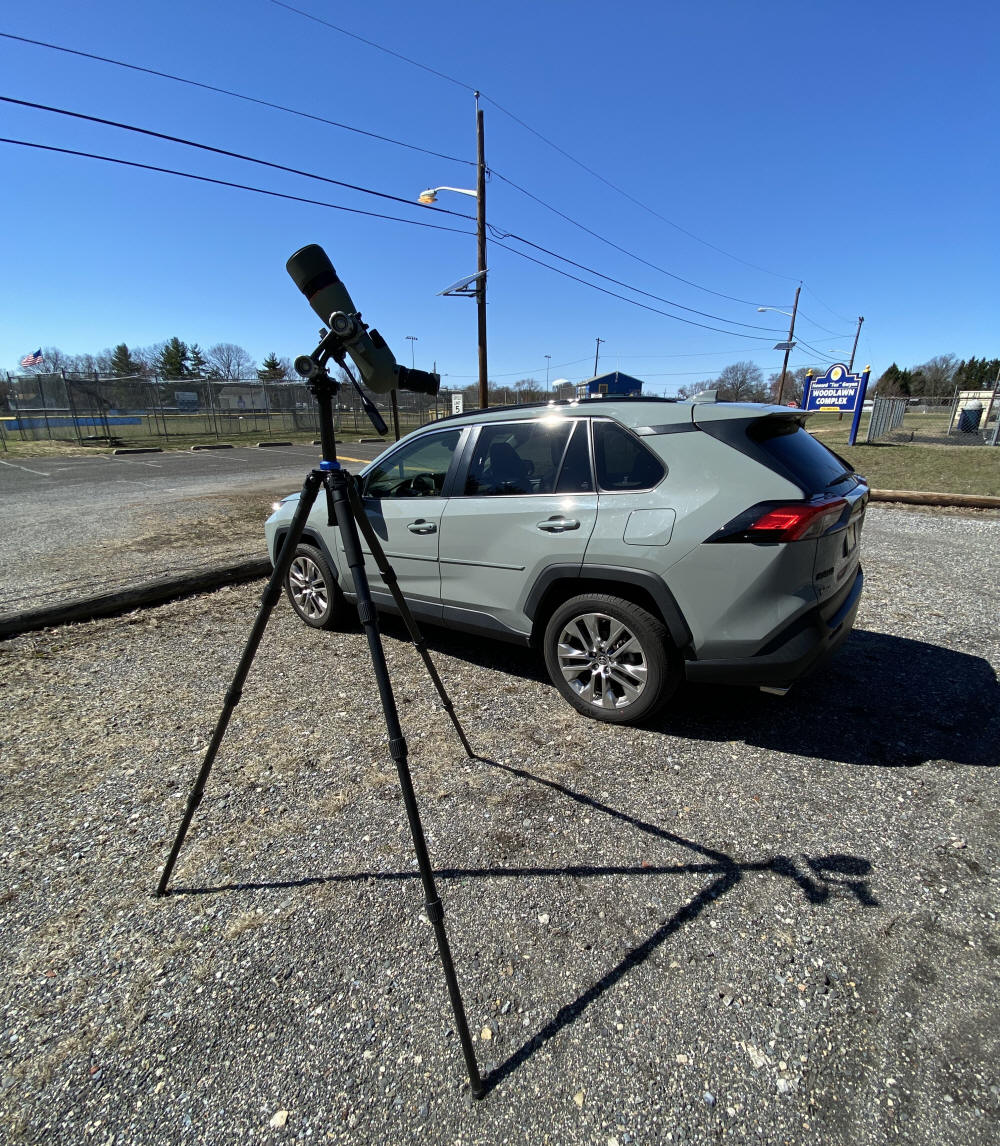
|
Here's my 88 mm Kowa apo spotting scope on March
18, 2025, set up in a parking at the baseball
field complex in Maple Shade, NJ. With this simple alt-azimuth
gimbal mount on a sturdy photo tripod, I was able find the
crescent Venus
in less than two minutes (here's
a close-up of the scope from the other side). First, make the shadow of the scope
(on the gravel to the right) as small as possible, then look at
the eyepiece lens from the side and move the scope
slightly as needed for a bright disc to glow on the eyepiece
lens (the Sun, so I don't look directly into the eyepiece).
I then aimed the scope upwards 11° using the scale on the
altitude axis (which is somewhat coarse with 7.5°
increments). Then I looked into the eyepiece and adjusted the
position slightly and there was the thin crescent Venus at 1:52
pm EDT. I picked a nominal time of 2 pm EDT because that's when
Venus would be directly above the Sun. The relatively wide
spacing resulted in only a few airborne seeds,
highlighted by forward scattering, from whizzing across the
field of view. They can be highly
distracting when looking closer to the Sun in the daytime.
Venus will
reach inferior conjunction on March 22, about 8.4°N ecliptic
latitude, at 9:07 pm. That relatively large span allows for easy
spotting with favorable weather as it has been on March 17, 18 &
19. As a result, I spotted Venus at sunset on March 17 & 18,
then before sunrise on March 18 & 19. So for two nights in a
row, I saw Venus at "both ends" of the night, and Venus was
still the
"evening star" at the morning sightings (prior to
inferior conjunction). So far, Venus was visible with unaided
eyes in the evening, but optical aid (binoculars) are needed in
the morning. The daytime crescent, around 2 pm on March 18 & 19, was exquisitely
thin, 1.8% and 1.5% illuminated respectively, with the cusps
approaching 180° separation and the disc itself seemingly
present (probably an illusion). It was a sublime sight at 60x in the
spotting scope.
Here's a sighting log for the dates around the current inferior
conjunction, sunrise, midday and sunset. Venus was observed on
March 22, 2025, as a result, it has been observed on four of the
last five conjunction days. The only exception
during that span was the superior conjunction of June 4,
2024, when Venus was occulted by the Sun for two days, so it was
impossible to see. |
Venus and Mercury
March 9, 2025
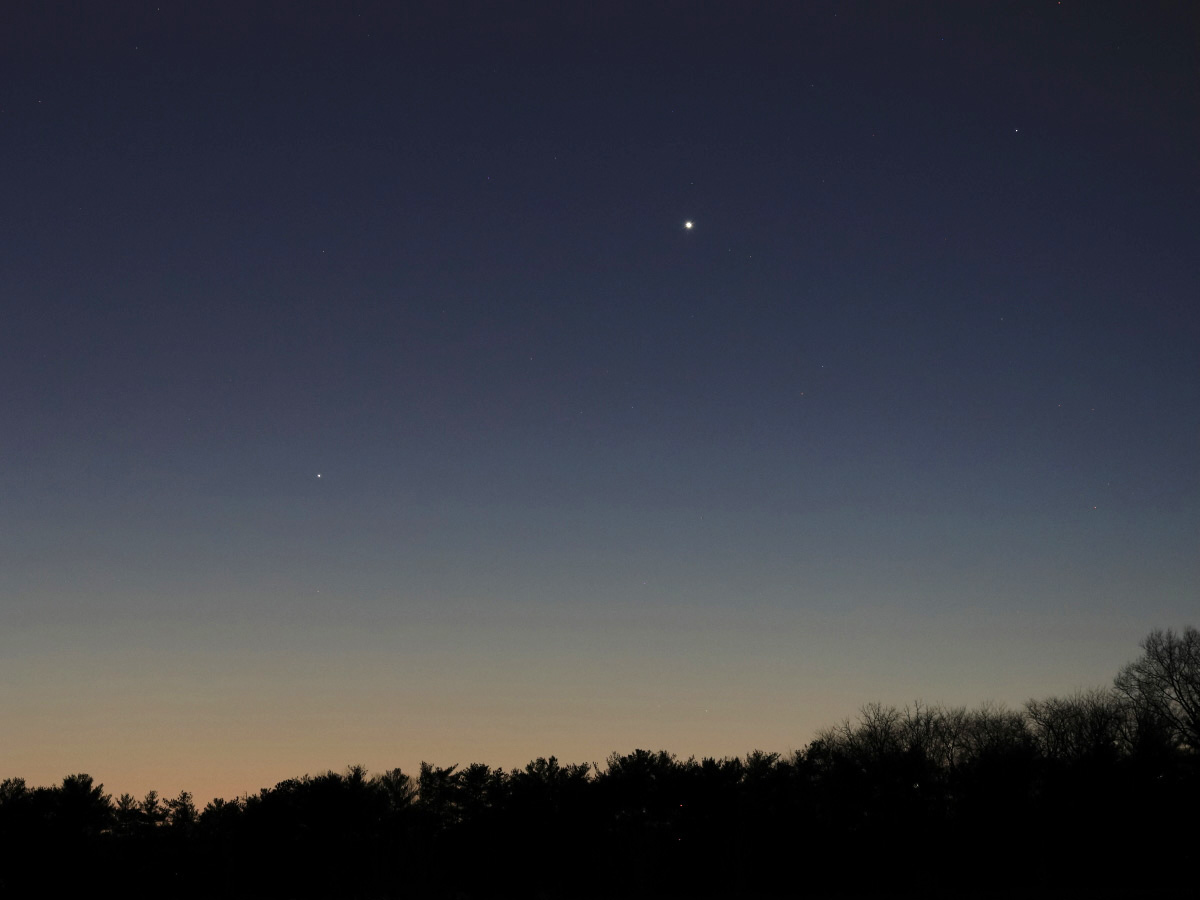
|
The brilliant planet
Venus was joined
by the other inner planet,
Mercury, on March
9, 2025, as seen in this view from Bishops Gate
in Mt Laurel, NJ. This snapshot
of them is a single raw frame taken at 7:59 pm EDT with a Canon
EOS RP DSLM camera and a Canon 100 mm f/2.8L macro lens on a
fixed tripod. It was exposed 0.6 sec at f/4.0, ISO
1600, daylight white balance and mildly adjusted. It was cropped to
80% of the width
x 90% of the height of the original dimensions, a 4:3 ratio, for
a field 16.4° wide x 12.3° high. At the time of the picture,
Venus was magnitude -4.4 and 13.3° altitude; Mercury was
magnitude 0.0 and 6.1° altitude. The two were
6.1° apart.
Venus was
obvious with unaided eyes when I arrived at 7:05 pm, but I did
not see Mercury
until 7:20 pm with 8x42 binoculars, then unaided eyes at 7:32 pm
(sunset was at 7:01 pm, astronomical twilight ended at 8:31 pm).
Venus had reached 55.0 arc seconds diameter and was 6.8%
illuminated, a lovely thin crescent in my 88 mm spotting scope
at 60x. However, I could discern the crescent with my 8x42s.
Mercury, 7.7 arc seconds diameter, was a thick crescent, 38%
illuminated, but at 60x88, it was at best an oval blob due to
less-than ideal seeing, orientated with an approximate 8 o'clock
to 2 o'clock tilt. The star right of, and slightly above Venus,
is Algenib, which marks the southeast corner of the Great Square
of Pegasus. Mouseover for labels. |
Venus and the Crescent Moon
March 1, 2025
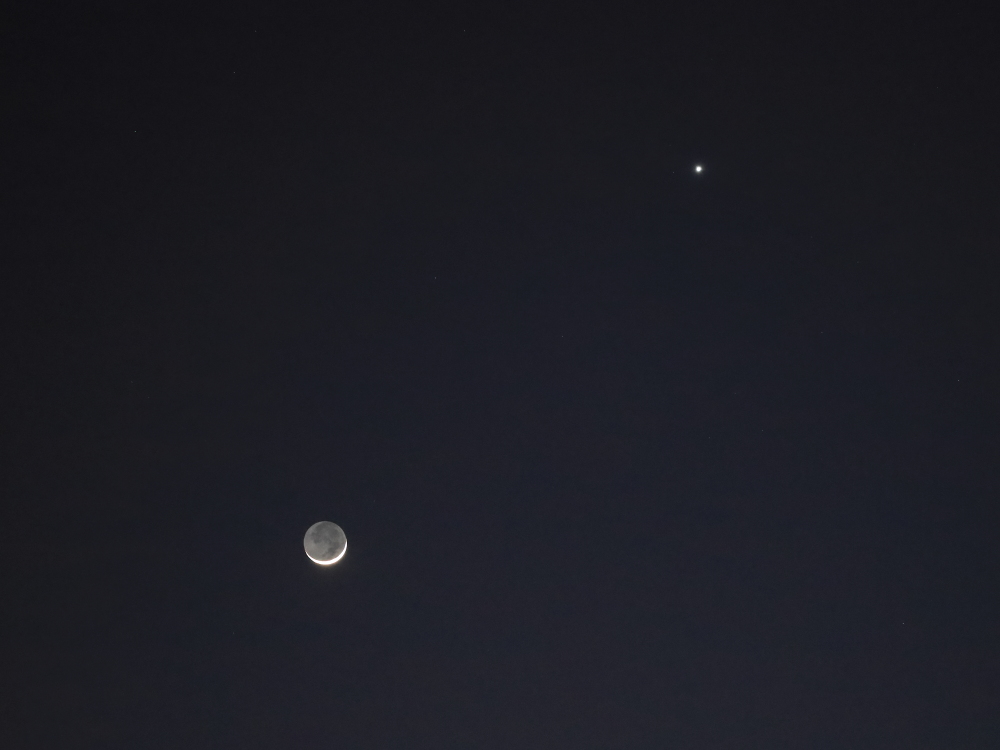
|
On
March 1, 2025, the two-day old, 5% illuminated
Crescent
Moon
joined the brilliant planet
Venus, itself a
14% illuminated crescent, although not visible here because of
Venus' small size plus being significantly overexposed. This snapshot
of them is a single raw frame taken at 6:51 pm EST with a Canon EOS RP DSLM camera and a Canon
100 mm
f/2.8L macro lens on a fixed tripod. It was exposed 1/15 sec at f/2.8, ISO
6400, daylight white balance. It was cropped to 64% of the width
x 72% of the height of the original dimensions, a 4:3 ratio, for
a field 13.1° wide x 9.9° high. At the time of the picture, the
Moon's altitude was 13.3° and Venus' was 18.0°. The two were
6.9° apart (center-to-center). The
glow of
earthshine
on the Moon's surface not illuminated by the Sun is prominent,
as it was visually.
I was surprised on my way to the baseball
field that I inadvertently spotted
Mercury with
unaided eyes through the car's windshield at 6:38 pm. It was
relatively bright in the very clear sky, about 10° below the
Moon, and I had to watch for a bit to be certain it wasn't an
aircraft. It remained visible for most of the time I was taking
pictures of Venus and the Moon, but being lower, it went into
the trees before the last shot was taken at 6:51 pm. Overhead at
the field, Jupiter
and Mars
were easy with unaided eyes. I did not get out binoculars for
Uranus overhead, and I didn't attempt to see Saturn or Neptune,
too low for my belated start this evening (and now maybe lost in
twilight anyway). |
22.5 hr old Crescent Moon
February 28, 2025
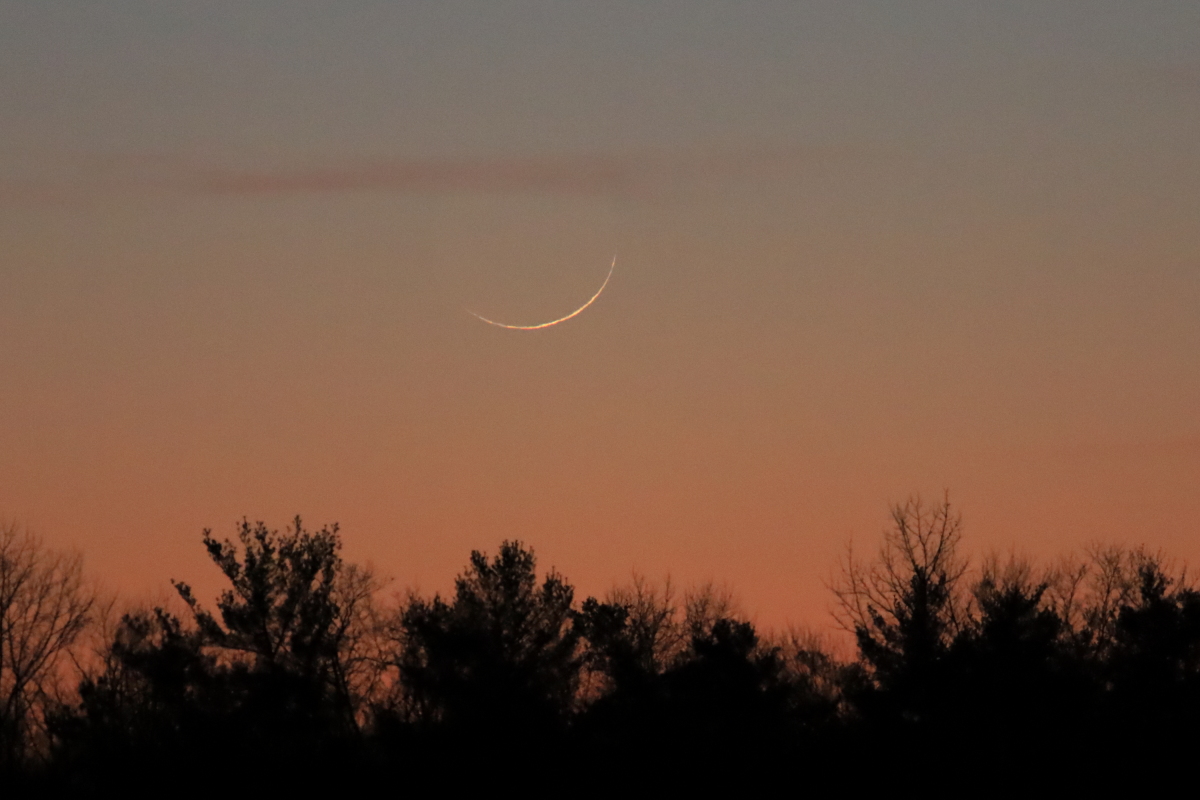
|
On
February 28, 2025, the thin
Crescent
Moon was
spotted at Bishops Gate in Mt Laurel, NJ, at 6:14 pm EST using
12x50 binoculars. At the time, it was 22 hr 29 min
old after New
Moon, which was at 7:45 pm on Feb 27, and 1.1% illuminated
(here's a WinJUPOS
synthetic image). Sunset was at
5:51 pm and the crescent was subsequently seen with unaided
eyes. It was a fine view with an 88 mm spotting scope at 60x. This snapshot
is from a single raw frame taken
at 6:34 pm with a Canon EOS RP DSLM camera and a Canon 400 mm
f/5.6L telephoto lens on a fixed tripod. It was exposed 1/40 sec at f/5.6, ISO
12,800.
White balance was set to automatic ambience, but little
processing otherwise. It was cropped to 67% of the original dimensions for
a field 3.5° wide x 2.3° high. At the time of the picture, the
Moon's altitude was 2.7° vs. 6.2° when first sighted. I'm not
sure if it's just an illusion, but the rest of the lunar disc
outside the thin crescent seems to be illuminated by a faint
glow of
earthshine. |
Crescent Venus
February 25, 2025
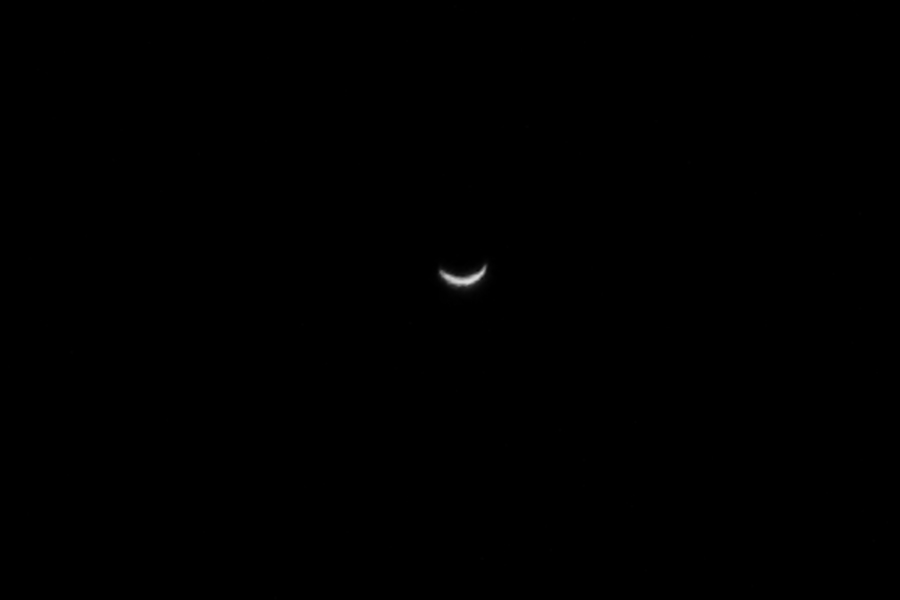
|
On
February 25, 2025, the thinning
crescent of
Venus was 17.4% illuminated
and 36.7° altitude at 7:24 pm EST when this snapshot
was captured in a dark sky 7 minutes after the end of
astronomical twilight. This is from a single raw frame taken
with a Canon EOS 7D Mk II DSLR camera (APS-C sensor) and a Tamron 150 to 600 mm zoom lens,
on a fixed tripod, set to 600
mm focal length. It was exposed 1/1600 sec at f/16, ISO 800.
The only processing was converting the daylight color balance as
captured to monochrome. It was cropped to 11% of the original dimensions for
a field 0.23° wide x 0.16° high. Venus was 46.6 arc sec apparent
diameter at the time, yielding a 136 μm diameter image on the
sensor, about 33 pixels. |
Crescent Venus
February 17, 2025
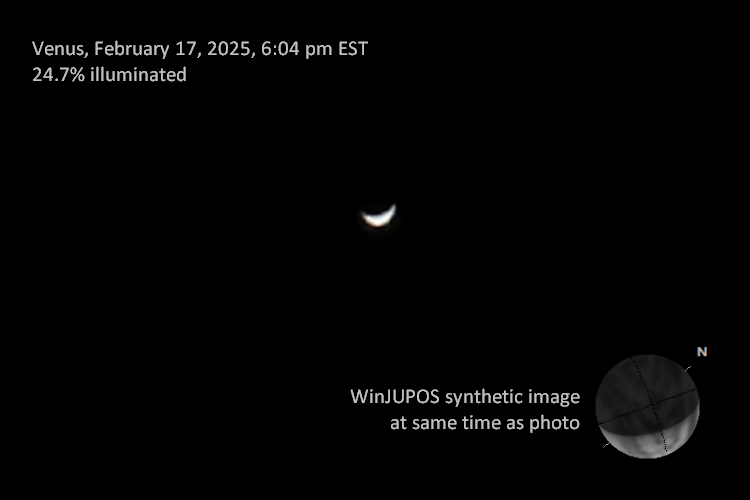
|
On
February 17, 2025, as Venus was approaching
inferior conjunction (see below), it presented a thinning
crescent, 24.7% illuminated at 6:04 pm EST when this snapshot
was captured in a still-blue sky 25 minutes after sunset. This
is from a single raw frame, unprocessed, taken with a Canon EOS
RP DSLM camera and a Tamron 150 to 600 mm zoom lens, on a fixed
tripod, set to 600
mm focal length. It was exposed 1/2000 sec at f/16, ISO 1600.
The brief exposure was needed to offset (somewhat) the effects
of poor seeing and jiggle from a stiff breeze that was blowing.
The result was a black background even though set to daylight
white balance (also a testament to Venus' brilliance). It was
cropped to 7% of the original dimensions for a field 0.25° wide
x 0.17° high. Venus was 41.1 arc sec apparent diameter at the
time, yielding a 120 μm diameter image on the sensor, about 21
pixels. Mouseover to clear labels. |
Venus at Inferior Conjunction, March 22, 2025
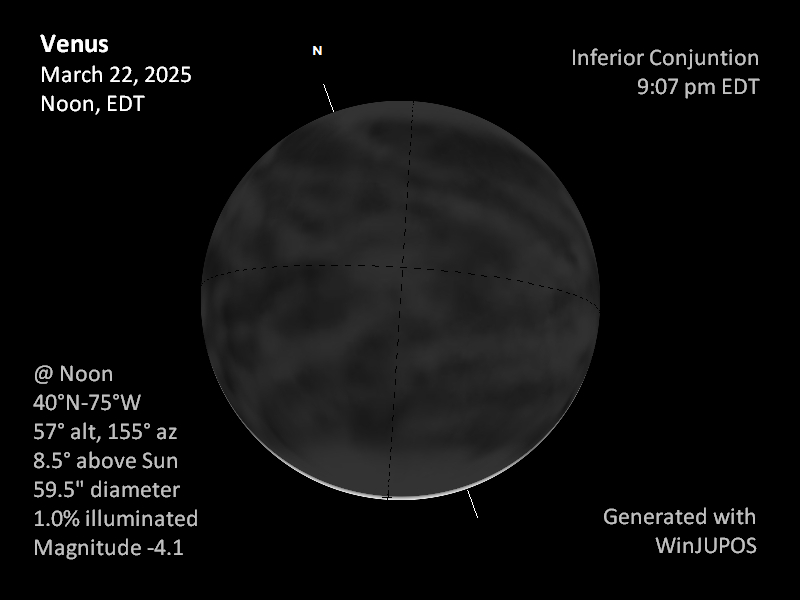
|
Click here for a table of Venus' recent solar conjunctions
that have been observed.
Mouseover to de-label this illustration. Interestingly, can you figure out
how Venus can be 8.4° from the Sun at conjunction, although it's
ecliptic inclination is just 3.4°?
Also, see
Bob King's February 2025
crescent Venus article at S&T online.
I missed Venus' inferior conjunction on June 3, 2020, due to
clouds, but I did see the delicate crescent (0.1% illuminated)
on June 1 with my 88 mm apo spotting scope at 60x when Venus was
just 3.1° from the Sun. It was perhaps the most sublime sight I ever saw
in the sky. The best
pictures of this conjunction I've seen were taken by Nicolas Lefaudfeux,
but to me, they pale compared to the visual view I had.
In addition, Venus' considerable northerly ecliptic latitude
near inferior conjunction will allow sighing of Venus in
the morning before sunrise for a few days or so before inferior
conjunction, when it's still technically the "Evening Star"
Hesperus. Starting on the morning of March 23
for our location, it becomes
Phosphorus, the "Morning Star".
Here's a table of morning rise times for the Sun and Venus
for a few days before inferior conjunction. |
Click here
for the previous page.
Click here
for an index to all previous SJAstro pages.


















